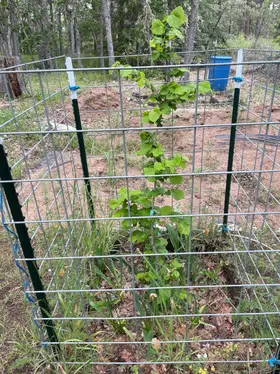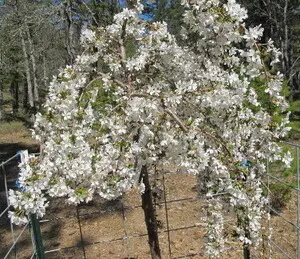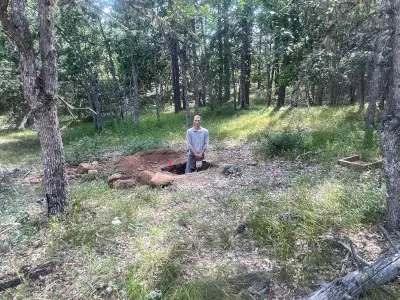A Tree Grave

A hazel nut tree growing in a tree grave is ready to pollinate
A key reason why people choose to rest in the Herland Forest is that they want their remains to nurture the growth of a tree—often a specific type of tree.
Here in the Pacific Northwest, the hazelnut is a very popular tree. It’s prolific and fast growing, yielding nuts in as little as five years. But it’s not a solitary tree; to do its best, it needs a companion.
We can greatly increase the nut yield by planting a second hazelnut near by as a pollinator. Naturally we can’t plant a tree on someone’s grave before their time comes, but we can plant a fast growing pollinator tree next to their grave so that it will have a head start. While planting individual trees is a good thing for the environment, our goal is to go beyond that to create and protect the living, interactive web that is a forest. Tree graves have an important role to play in that work.
Many of the people who choose to rest in the Herland Forest care about reducing their carbon footprint. The key to making that happen is carbon sequestration. When a body is converted to compost through natural organic reduction, just spreading the compost on the surface does little to reduce the person’s carbon footprint. Over the next couple of years, the organic matter will decompose and return to the atmosphere as carbon dioxide. That sort of wastes one’s good intentions as far as reducing their carbon footprint.
The better option is to bury the compost, thereby sequestering the carbon in the ground. Fungi will then transform the compost into soil that retains the moisture the tree will need to get through the dry months. More importantly, sequestering the remains will secure the vital minerals contained in the compost. Those elements are vital to the forest’s ability to regenerate life; for example, without magnesium, the plants can’t create the chlorophyll they need in order to turn sunlight and carbon dioxide into more growth.

A weeping cherry offers early spring pollen to the bees
Without sequestration, essential elements contained in the compost—elements such as magnesium, potassium, phosphorus, and calcium—will literally just become “dust in the wind.”
A standard Herland grave is a little over three feet wide, three feet deep and six feet long, but a “tree grave” is three by three by three. Our soil has a lot of clay, so our hand-dug graves are able to function as overgrown flower pots in which the fungi native to our forest convert the decedent and two hundred gallons of wood chips into soil.
A tree grave functions in a similar way, but since it doesn’t contain a decedent to “power” the decomposition by providing the nitrogen compounds the fungi require, we have to fill a tree grave differently. We start out with a hundred gallons of woodchips which will serve as a “water battery” to help the young tree bridge the dry months of late summer. On top of that we add fifty gallons of the high nitrogen compost produced by our goats and sheep. This creates about 18 cubic feet of fertile space for the transplanted tree to get established in. The tree grave is then give a dirt cap to finish off the growth pocket.

Our sexton finishing a Guardian’s tree grave
Finally we plant the tree on top of that, adding a wood chip mulch cover to help the tree grave retain water.
Herland has a Natural Organic Reduction facility on site. The NOR process converts a human body into about three 55-gallon drums of compost. When a family decides that they only want to take possession of some of that compost, they often ask for the remainder to used in the forest. In that case, we create a tree grave in a location that we believe will expand the diversity of the forest.
Herland is a permaculture forest that’s intended to help nourish the birds, bees, and butterflies that pass this way. We’re on a migratory bird route, and so far we’ve sighted more than a hundred types of birds visit the Herland Forest on their way to elsewhere.
All of the birds sighted in the Herland Forest in the summer of 2011.
Humans are naturally focused on the trees that serve their interests, and we’re happy to plant those domesticated types, but we also want to plant the work-a-day trees that humans often overlook. Many trees that are not particularly useful to humans, play key roles in the support of the birds and bees that make the forest their home.
When someone decides that they don’t want to claim all of the compost produced by a natural organic reduction, we use the surplus material to create a tree grave that will take the Herland Forest one step closer to becoming a unique living memorial that affirms someone’s commitment to life.

Comments
A Tree Grave — No Comments
HTML tags allowed in your comment: <a href="" title=""> <abbr title=""> <acronym title=""> <b> <blockquote cite=""> <cite> <code> <del datetime=""> <em> <i> <q cite=""> <s> <strike> <strong>